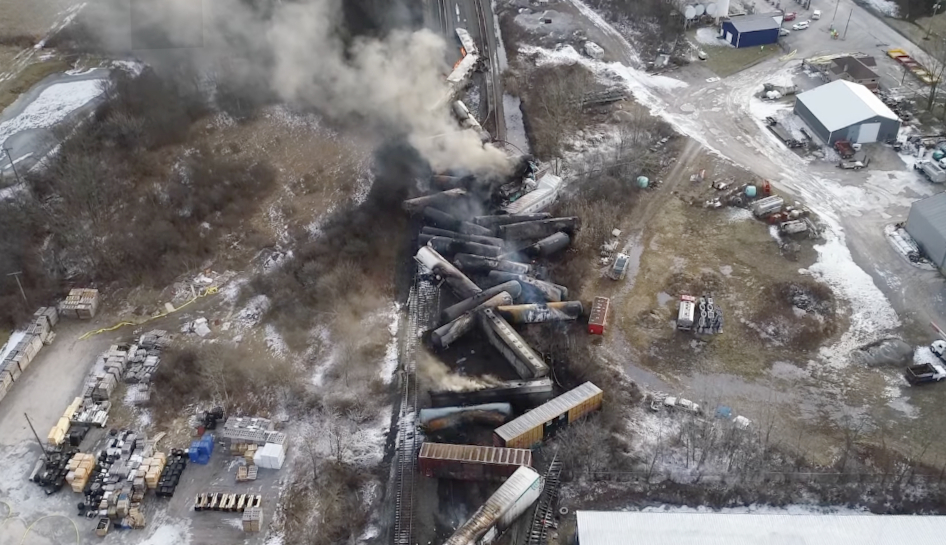Months Of Toxic Chemical Exposure: The Ohio Train Derailment's Lingering Impact On Buildings

Table of Contents
Assessing the Extent of Building Contamination
Determining the full extent of building contamination following the Ohio train derailment presents significant challenges. The sheer scale of the event, coupled with the unpredictable dispersal patterns of the released chemicals, complicates assessment efforts. Several factors hinder a complete understanding of the situation:
- Difficulty in accessing all affected buildings: Many properties may be privately owned, hindering comprehensive testing and assessment. Gaining access requires navigating complex legal and logistical hurdles.
- Variation in levels of contamination: The concentration of toxic chemicals varies significantly depending on proximity to the derailment site, prevailing winds at the time of the incident, and the type of building materials. Porous materials like wood may absorb more chemicals than non-porous materials like concrete.
- Need for advanced testing methods: Detecting trace amounts of these volatile organic compounds (VOCs) requires sophisticated analytical techniques, going beyond standard environmental testing. Specialized equipment and expertise are necessary for accurate assessment.
- Ongoing monitoring efforts: Various agencies, including the EPA and state environmental protection agencies, are conducting ongoing monitoring and testing. However, the long-term nature of the contamination means continuous assessment is crucial. This "building contamination assessment" is a complex, ongoing process.
Long-Term Health Risks Associated with Contaminated Buildings
The long-term health risks associated with exposure to the toxic chemicals released during the Ohio train derailment are a serious cause for concern. Residents and workers in contaminated buildings face a heightened risk of various health problems, including:
- Respiratory problems: Exposure to vinyl chloride and other released chemicals can lead to asthma, bronchitis, and other respiratory illnesses, especially in vulnerable populations like children and the elderly.
- Cancer risks: Certain chemicals released during the derailment are known or suspected carcinogens, increasing the long-term risk of developing various types of cancer. Further research is needed to fully understand the cancer risks associated with this specific event.
- Neurological damage: Some of the chemicals involved can negatively impact the nervous system, potentially leading to neurological disorders and cognitive impairment.
- Reproductive issues: Exposure to these chemicals may also pose risks to reproductive health, affecting fertility and increasing the risk of birth defects. The long-term effects on reproductive health remain an area of ongoing investigation.
These "toxic chemical exposure health effects" underscore the urgent need for comprehensive health monitoring and support for those living in affected areas.
Remediation and Cleanup Efforts for Contaminated Structures
Remediating buildings affected by the Ohio train derailment presents significant complexities and challenges. The process is expensive, time-consuming, and requires specialized expertise:
- Decontamination techniques: Effective decontamination may involve various techniques, from specialized cleaning and air filtration to, in severe cases, complete demolition and rebuilding. The choice of "building remediation" strategy depends heavily on the level and type of contamination.
- Cost and logistical challenges: Large-scale remediation efforts require substantial financial resources and meticulous logistical planning. Coordinating access, managing waste disposal, and ensuring worker safety add further complexity.
- Legal and regulatory hurdles: Navigating the legal and regulatory landscape, involving insurance companies, government agencies, and potentially numerous lawsuits, adds another layer of complexity to the remediation process.
- The role of insurance companies and government agencies: The responsibility for funding and overseeing cleanup efforts is a subject of ongoing debate, involving various stakeholders, including insurance companies, government agencies, and the Norfolk Southern Railway.
The Socioeconomic Impact on Affected Communities
Beyond the environmental and health concerns, the Ohio train derailment has had a profound socioeconomic impact on the affected communities. The consequences include:
- Property devaluation: The stigma associated with contamination significantly reduces property values, leaving homeowners with diminished assets and limited options.
- Business closures and economic downturn: Businesses in affected areas face losses, disruptions, and potential closures, leading to job losses and economic hardship.
- Displacement of residents: Some residents may be forced to relocate due to health concerns or the unviability of their properties, disrupting their lives and creating additional challenges.
- The need for long-term economic support: Recovering from such a devastating event requires substantial long-term economic support to rebuild infrastructure, stimulate the local economy, and aid affected residents and businesses. This "Ohio derailment economic consequences" necessitate a comprehensive recovery plan.
Conclusion
The Ohio train derailment's lingering impact on buildings is profound and multifaceted. The extent of contamination, the associated long-term health risks, the complexities of remediation, and the socioeconomic implications underscore the severity of this ongoing environmental disaster. The lasting impact of the Ohio train derailment on buildings requires sustained attention, thorough remediation, and robust long-term support for affected communities. Understanding the long-term effects of the Ohio train derailment on buildings is crucial. We must stay informed, support affected communities, and advocate for stricter regulations to prevent future incidents and ensure environmental justice. Let's work together to mitigate the ongoing consequences of this tragedy and prevent similar disasters from devastating our communities.

Featured Posts
-
 Ufc 315 Betting Odds Predictions And Weekend Winner Analysis Mm Amania Com
May 12, 2025
Ufc 315 Betting Odds Predictions And Weekend Winner Analysis Mm Amania Com
May 12, 2025 -
 Onex Fully Recoups West Jet Investment With 25 Stake Sale
May 12, 2025
Onex Fully Recoups West Jet Investment With 25 Stake Sale
May 12, 2025 -
 Prince Andrew Accusers Claim 4 Days To Live Following Bus Accident
May 12, 2025
Prince Andrew Accusers Claim 4 Days To Live Following Bus Accident
May 12, 2025 -
 Smeshen Sreten Nikola Okikj I Kevin Khart Vo Video
May 12, 2025
Smeshen Sreten Nikola Okikj I Kevin Khart Vo Video
May 12, 2025 -
 Decouvrez La Vie Et L Uvre De Chantal Ladesou
May 12, 2025
Decouvrez La Vie Et L Uvre De Chantal Ladesou
May 12, 2025
